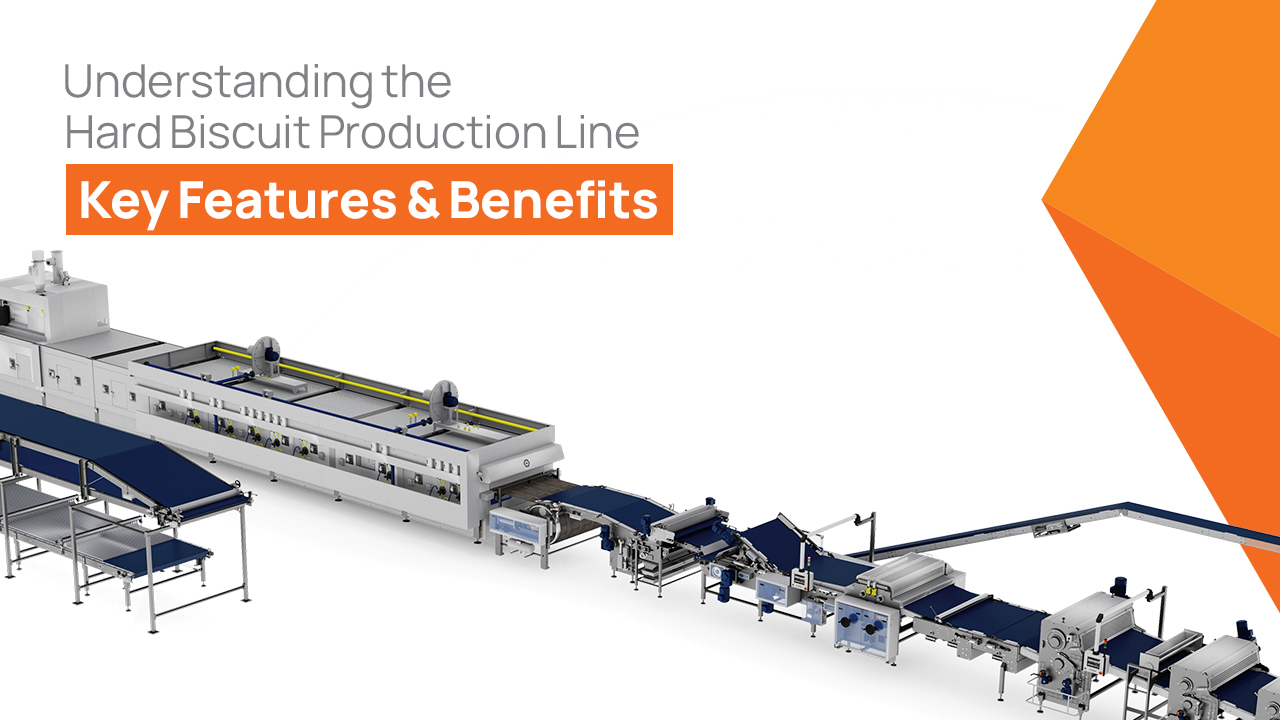A hard biscuit production line is a robust manufacturing setup that utilises many machines and equipment to produce biscuits on a large scale. The production line typically comprises several stages: mixing, shaping, baking, and packaging. In this article, we will discuss the key features and benefits of a hard biscuit production line. But before that, let us first understand the basics of biscuit production.
Basics of Biscuit Production
A biscuit production line consists of several key components, each performing a specific function in the manufacturing process. The first stage of the production line involves mixing the dough. This is done using a dough mixer, which combines all the necessary ingredients in the correct proportions. The next stage involves shaping the biscuits which is done using a rotary cutter. The shaped biscuits are then transferred to a baking oven. Post this, the biscuits are packaged using a packaging machine that wraps them in airtight packaging to ensure freshness.
Now let’s proceed further and talk about the top features of a production line of hard biscuits.
4 key features of a Hard Biscuit Production Line
- Automated equipment
- Dough mixing and kneading
- Cooling systems
- Packaging solutions
Automated Equipment
Automated equipment enhances the efficiency of the production line and eliminates the need for manual labour. With advanced machinery such as automated mixers, rotary cutters, and high-capacity ovens, the overall output of the production line increases manifold. These automated equipment can operate for long intervals in time and ensure a consistent quality and texture of the biscuits.
Dough Mixing and Kneading
Another essential feature of the production line is dough mixing and kneading. Precision and accuracy are everything when it comes to the efficiency of the production line. Achieving the correct balance of ingredients through precise mixing ensures a consistent dough that is well-integrated and without any lumps. Modern production lines use high-efficiency mixers to maintain uniformity across batches.
In addition to this, proper kneading develops gluten, which contributes to the desired firmness and chewiness of hard biscuits. With the help of advanced mixing and kneading technology, hard biscuit production line manufacturers can enhance product quality while optimizing efficiency.
Cooling Systems
Cooling systems play a vital role in the entire production line, ensuring that biscuits maintain their quality and texture after baking. Once the biscuits leave the oven, they are still warm and need to cool down to prevent moisture buildup. This is where cooling systems come into the picture. Today’s production lines use technologies like conveyor belt cooling tunnels that facilitate rapid and uniform cooling.
This method of controlled cooling process not only preserves the desired crunchy texture but also helps stabilize biscuits, making them easier to pack.
Packaging Solutions
The last step of the production line is packaging. Advanced packaging technologies like vacuum sealing and modified atmosphere packing help protect biscuits from moisture, air, and light. Customisable packaging options like resealable bags and attractive boxes also help in increasing the final appeal of the product. By investing in ingenious and hi-tech packaging solutions, manufacturers can create a lasting impression on their customers.
Now that we’ve learned about key features, let’s talk about the benefits too.
4 essential benefits of a Hard Biscuit Production Line
- Increased production efficiency
- Quality control
- Flexibility in production
- Improved safety standards
Increased Production Efficiency
One of the most significant advantages of a hard biscuit production line is the boost in production efficiency. These automated lines streamline the entire production process, from dough mixing and forming to baking and packaging. This reduces manual labor, speeds up production, and minimizes downtime.
Consistent speed and automation allow manufacturers to meet high demand with less effort, reducing production costs while ensuring a steady supply of products.
Quality Control
Maintaining consistent product quality is crucial in the competitive biscuit market. A hard biscuit production line is equipped with advanced sensors and monitoring systems to ensure each batch meets specific quality standards. Automated temperature controls during baking, precision in dough forming, and regulated moisture levels all contribute to uniform biscuits.
This reduces the likelihood of human error and guarantees that customers receive the same high-quality product every time.
Flexibility in Production
Hard biscuit production lines are versatile and can be easily adjusted to accommodate various biscuit types, shapes, and sizes. Whether producing large quantities of a single product or smaller batches of different types, these lines offer the flexibility to switch between products quickly and efficiently.
This adaptability is crucial in meeting market demands for different flavors, shapes, and textures, providing manufacturers with the agility to respond to consumer preferences.
Improved Safety Standards
With a strong focus on automation, a hard biscuit production line minimizes human intervention, reducing the risk of accidents in the factory. These systems are designed with safety features such as automated shutdowns in case of malfunctions, temperature controls to prevent overheating, and protective guards to shield workers from moving parts.
This leads to a safer working environment and compliance with food safety regulations, ensuring the end products are not contaminated during production.
A hard biscuit production line is a comprehensive system that brings automation, precision, and safety into the biscuit-making process. With advanced technology in dough mixing, baking, cooling, and packaging, manufacturers can significantly improve production efficiency while maintaining high-quality standards.
The versatility in production allows businesses to adapt to market trends, ensuring that they meet consumer demands with ease. Additionally, safety features integrated into these systems help in creating a safer workplace and complying with food safety regulations.
By investing in a modern hard biscuit production line, companies can achieve consistency, reduce costs, and enhance their overall operational effectiveness.



